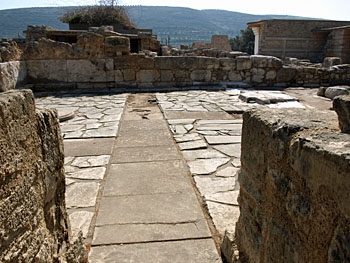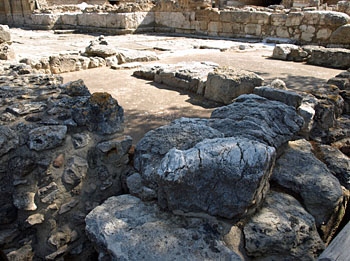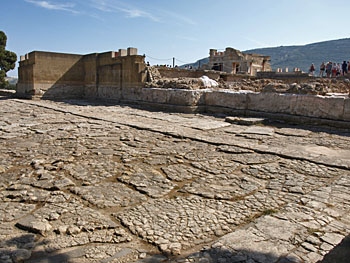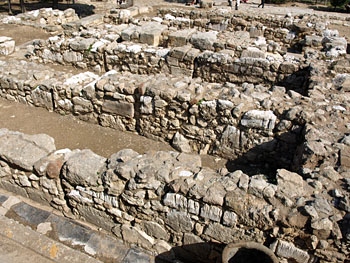
The Neolithic prologue and the Early Bronze Age
The Palace of Knossos is located in North Central Crete just south of the outskirts of Heraklion on the Kephala hill. The site was first occupied some time around 7000 BCE in what is called the Aceramic Neolithic period (aceramic because no pottery was produced). The Bronze Age was not to begin for a further four thousand years. It is thought that Knossos was the first and oldest Neolithic site in Crete and the first indication of human activity on the island is located in the exact area where the Palace and its Central Court were to be located. So humans had been continually active on the site for five thousand years before the First Palace was constructed.
Although the Neolithic gave way to the Bronze Age, when no doubt new peoples arrived from the East, there is no evidence that the original population on the Kephala Hill was replaced by the newcomers. More likely was a gradual transition from neolithic to bronze age practices.
The Early Minoan II period seems to have been of some importance at various sites on Crete. Jan Driessen thinks it was important at Knossos as well. A large amount of EM IIB pottery has been uncovered at Knossos. It was found in locations which suggest that the ground had been cleared for construction during EM III.
As at other Palatial sites on Crete, large scale building preceded the actual construction of the First Palace. At Knossos this building activity appears to have begun during Early Minoan III. On the palace site itself there is very little evidence from this late Prepalatial period (Early Minoan III-Middle Minoan IA). What evidence there is tends to be found on the perimeter of the later palace or on the slopes of the Kephala hill on which the palace was built.
For example, there are prepalatial walls at Knossos (EM III-MM IA) to the north and south of the later palace. These walls already had the north-south, east-west orientation which would be used in the building of the later palace. Just outside the area where the palace was built a number of structures probably date to the prepalatial period. The Southwest Houses contained pottery from EM IIB-MM IA. A large wall running south from the north west corner of the area where the first palace would later be built may well have been a terrace wall supporting a flat level on which some structure was built. Very little can be said at present of this structure except that it was not a palace. In the West Court some houses were discovered under the kouloures which were built during the protopalatial period.
The First Palace
Although some archaeologists argue on the basis of the limited finds from EM III-MM IA for a continuity in building on the site from the prepalatial period, Colin Macdonald, who has spent much of his career excavating different parts of the Palace, finds the evidence unconvincing and it is still generally accepted that the First Palace was built during Middle Minoan IB-IIA, with the southern half possibly being completed a little later than the West, North and East wings.
By the end of MM IIA the palace covered an area of almost 10,000 square metres on the ground floor alone. Access to the Palace was easier during the Protopalatial period than it was to become later. It therefore continued in one form or another for about five hundred years. It signified the transition of Minoan Crete from a clan-based society into a hierarchical one, with an urban elite, though some archaeologists claim that there may have been several competing elite groups, what they call a heterarchy.
At other Palace sites, like Phaistos, the old palace suffered a major destruction. The ground was subsequently levelled and a new palace was constructed. This does not appear to have happened at Knossos. According to Colin Macdonald the construction of a monumental building around a central court at Knossos may have been "a long project that lasted for several generations, punctuated by destructive episodes, notably in MM IB and reaching a conclusion in MM IIA only to be damaged at the end of that period and again in MM IIB, after which it was largely rebuilt over MM III along the same lines but with markedly different architectural elements."
So, although parts of the Palace certainly suffered from earthquake destruction a number of times over the ensuing five hundred years, the Old Palace was never levelled or covered over in order for a new palace to be built on top. New areas were added to the Palace and sections damaged by earthquake were rebuilt, often in a different way from the sections that preceded them. But the palace was never replaced by a completely new building.
From the First Palace period would date the West Facade which is thought to have had an upper floor with windows looking out over the West Court. Also dating from this period would have been the raised walkways in the West Court, and the kouloures, three large circular pits sunk into the West Court and whose use is still a subject of debate. The royal Road, which approaches the north west corner of the palace from the Minoan town, was one of a number of roads that would have been constructed by some central authority and were yet another indication of the transformation that was taking place in Minoan society. By Middle Minoan III there were also drainage systems in parts of the Minoan town and in the Domestic Quarter and the North Entrance of the Palace.
Another innovation of the First Palace period were the magazines which take up much of the ground floor of the West Wing of the Palace and make such an impressive sight for visitors today. Their current appearance, however, dates from a later period. There has been much discussion about the role of the storage facilities in the Minoan Palaces and some have argued that the Palaces acted as redistribution centres for produce coming in from the countryside. Howevever it has been calculated that the storage capacity of the Palaces would not have been adequate for such a task and it is more likely that the storage was for goods consumed by people working at the Palace or those attending the feasting ceremonies which seem to have been such an important part of Palace life.
There is already evidence by the Middle Minoan IB period of a strongly hierarchical aspect to this feasting with one deposit yielding up a collection of vessels of varying quality with very few of the highest quality and rather more of lower quality.
There were certainly workshops in and around the Palace. Loomweights provide evidence of weaving activity but it is not known whether workshops were directly under the control of the Palace. No sign has yet been found of a large area outside the palace devoted to skilled craft production like Quartier Mu at Malia.
The New Palace
At the end of Middle Minoan IIB other palaces in Crete were so thoroughly damaged that they had to be rebuilt. It seems that this was not the case at Knossos, which may have been far enough away from the epicentre of the earthquake to escape the complete devastation that hit the palace at Phaistos. During the Middle Minoan IIIA period which followed the palace destructions elsewhere, the Palace at Knossos did not undergo any dramatic architectural transformation. Other changes, however, became noticeable. For example, the writing script at Knossos had been Cretan Hieroglyphic while in the south at Phaistos, Linear A was preferred. Now Linear A came to Knossos and over a period of time it replaced the use of the Cretan Hieroglyphic.
Another major development at Knossos at the beginning of the Neopalatial period was the development of foreign trade, in particular in the South Aegean and Asia Minor. What all this meant for the position of Knossos on the island of Crete itself is not well understood.
That is not to say that changes in the Palace did not take place. Colin Macdonald claims that there were in effect three New Palaces which he calls the New Palace (MM IIIB), the Frescoed Palace (Late Minoan IA) and the Ruined Palace (LM IB). He also points out that there then followed the Mycenaean Palace. This categorisation is not universally accepted.
Knossos was hit by a massive earthquake at the end of MM IIIA and this resulted in major rebuilding work. Much of the West part of the palace was levelled and built over while basement rooms on the east side were filled with rubble to create new terraces for building on. So the New Palace effectively dates from MM IIIB. Then, towards the end of MM IIIB another earthquake struck, resulting in more demolition and rebuilding during LM IA. The palace we see today dates largely from this period.
The main changes to the Palace during the Neopalatial period included the filling in of the kouloures which resulted in an enlargement of the West Court. A major entry route into the palace passed along the Corridor of the Procession to the south of the West Facade and from there through the South Propylaeum, where stairs led to the first floor of the West Wing (but see page 1 of the Tour of the Palace where these structures are questioned). Also in the West Wing, the Throne Room with its adjacent lustral basin and associated rooms also dates from Middle Minoan III, though like so much else, the form of the room that we see now dates to a later period.
On the East side of the Central Court the Grand Staircase and the Domestic Quarters two floors below, are a creation of the Neopalatial period. Also on the East side was the Great East Hall, where more storage facilities were located on the ground floor. To the North East a new entrance was constructed using ashlar masonry and the North Entrance Passage was built and decorated with a famous wall painting (see logo at the of the page). The Neopalatial period also sees the widespread creation of wall paintings on a variety of subjects including the famous bulls and scenes of ceremonies.
The Final Palace period
Around 1450 BCE there was widespread destruction throughout the island of Crete. All the other palaces were destroyed as were many towns and villages, although it tended to be the prestige buildings that were primarily targeted. While there was some damage to the Palace at Knossos it was not destroyed in the same way as the other Palaces. Ashlar masonry went out of use, replaced by the increased use of gypsum. Architectural changes to the palace showed inferior quality of materials. A lot of the changes made during this period were removed by Evans during his excavation of the Palace and in Colin Macdonald's words "Evans had stripped most of the palace down to its Middle Minoan III to Late Minoan I skeleton, so that it's later plan is now difficult to reconstruct."
One of the most important developments during this period of the history of Knossos is the arrival of Linear B. Although there are differences between Linear A and Linear B scripts the most significant difference is that Linear B has been deciphered and is now known to be an early form of the Greek language spoken by the Mycenaeans while Linear A, which remains undeciphered, represents a different language. It seems likely that the Mycenaeans had a presence at Knossos from Late Minoan II onwards but the exact nature of that presence is not known.
When the Palace was finally destroyed a large number of clay tablets and sealings were baked, and therefore preserved, in the fire. The town survived the destruction of the palace which seems to have been left deserted but much of the evidence from this period, which would have formed the top layers over the site at Knossos were removed by Evans and so vital evidence about this period has been lost.
The date of the final destruction of the Palace at Knossos is still the subject of debate with suggestions varying from Late Minoan II, to Late Minoan IIA or IIIB. Macdonald favours a Late Minoan III A2 (1325-1300 BCE) date for the final destruction of what he calls the Linear B palace.





